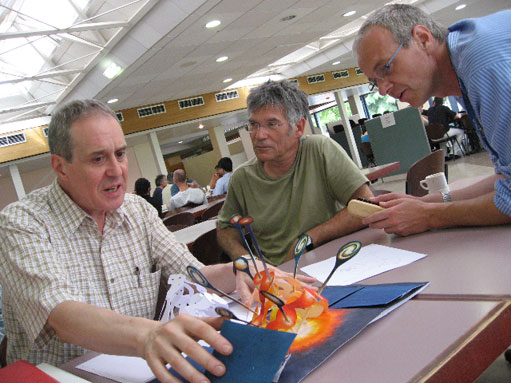
ATLAS e-News
23 February 2011
Making ATLAS pop
1 July 2008

Anton Radevsky shows Philippe Farthaouat and Christoph Rembser the Big Bang
“Here we are, building such a complex machine, and we’re all fascinated,” Markus Nordberg mused, sitting around a table in the CERN cafeteria with seven other ATLAS collaborators and “Mr. Pop-up,” Anton Radevsky.
A paper model of the surface buildings, shafts, and detector towered nearly 25 cm over the pages below, with two smaller pop-ups of the control room and a crane lowering a miniature end-cap toroid magnet down a shaft. This is the third double-page spread in the ATLAS pop-up book, currently under construction by Anton and Emma Sanders.
Anton visited the ATLAS cavern in 2006, when he undertook the project. “Until two years ago, I didn’t know about the ATLAS detector even though it was half-built,” he said. The project was put on hold as he was commissioned to do other books on shorter deadlines, but he’s already put half a year into the ATLAS pop-up.
“You don’t need a computer to do this,” says Anton, quite convinced that he would require a separate program for each book. Instead he brings structures to life straight from his imagination, starting by cutting rather than sketching. “It’s all empirical,” he says of his “many many attempts with scissors” before he is satisfied with a model.
ATLAS is not Anton’s first attempt at capturing a technical subject in pop-up form; his previous work includes spacecrafts, architecture, and the Wild West of the US. However, the ability to see what he is trying to re-create makes the project easier. High energy physics topics, such as the big bang, dark matter, supersymmetry, and even the particles themselves, are invisible. “Because you cannot see that, it’s all imagination,” says Anton.
Talk of parallel universes with Markus one evening cost Anton a few hours of sleep, such was his excitement over the realities suggested by theoretical physics. “Almost everything is possible,” he reflects with soft-spoken wonder.
“One of the most difficult things is to make a book that will be appreciated by the collaboration but also understood by the general public,” Emma points out. She is coordinating the project and co-authoring the book, writing the text and choosing photos that will share space with Anton’s structures.
The book may be only four double-page spreads long, but these are not your average pages. It manages to cover the magnitude of the LHC and ATLAS, the complexity of the detector, and the nature of the questions we seek to answer in high energy physics – all in three dimensions.
Emma is quick to recognize that the project is broader than herself and Anton: “If the book is interesting, it’s thanks to all the people in ATLAS who have contributed their time and ideas.” Some people are quite excited about the project, vowing to buy many copies for their Christmas gifts, if by any chance the project is completed before the end of the year.
